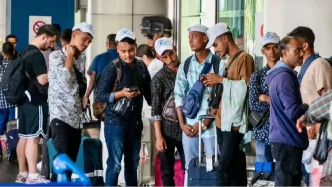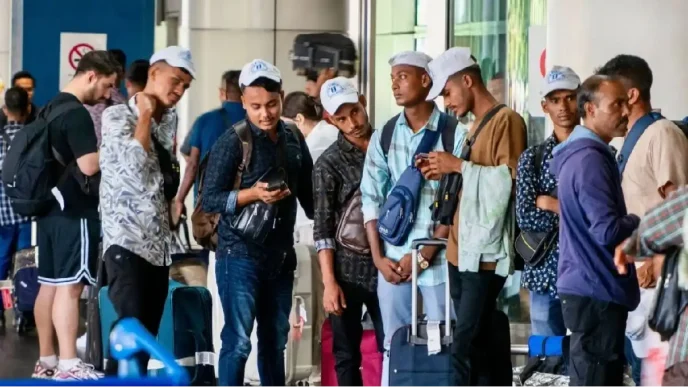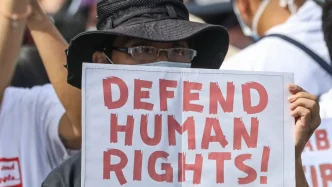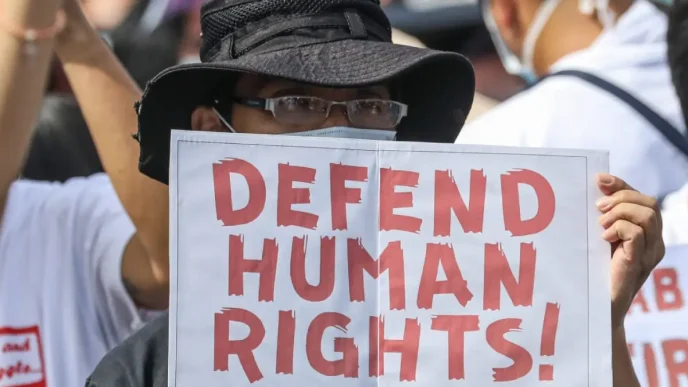Cambodia’s Prime Minister Hun Manet has issued a stark warning about the dangers of escalating nationalism on both sides of the Cambodia-Thailand border, urging politicians to refrain from exploiting long-standing territorial disputes for political gain. Speaking at a graduation ceremony on 19 February, Manet highlighted the risk of heightened tensions if border issues are politicised, calling for resolutions grounded in technical negotiations and historical legal frameworks rather than populist rhetoric.
The Cambodia-Thailand border, a perennial flashpoint in bilateral relations, remains a complex and unresolved issue, with some areas still lacking clearly defined markers. Manet’s comments come amid recent incidents, including a confrontation at Ta Moan Temple where Thai soldiers reportedly admonished Cambodian visitors for singing their national anthem. As both nations grapple with domestic political pressures, the prime minister’s appeal for calm underscores the delicate balance between asserting sovereignty and maintaining regional stability.
A History of Contention
The border between Cambodia and Thailand stretches over 800 kilometres, from the northern reaches of Oddar Meanchey province to the coastal areas of Koh Kong. Despite decades of negotiations, significant portions remain unmarked or disputed. According to Manet, from Choam in Oddar Meanchey’s Anlong Veng district to Cham Yeam in Koh Kong, there are 74 border posts in place. However, from Mum Bei in Preah Vihear to Cham Yeam, no such markers exist, leaving vast areas open to interpretation.
Cambodia relies heavily on a 1908 map, drawn up by the Indochina and Siamese Border Delimitation Commission during the French colonial era, as the basis for its territorial claims. Yet, discrepancies persist. “We have not yet agreed on the 73rd post. According to the 1907 map, it was there. Now it is moved. We disagree. Let’s continue to negotiate,” Manet said during his address, as reported by The Phnom Penh Post.
The prime minister acknowledged the slow pace of progress, noting that efforts to resolve these disputes have been ongoing since 1998. While some markers have been identified, others remain missing, perpetuating uncertainty. This ambiguity has often fuelled tensions, most notably during the 2008-2011 skirmishes near the Preah Vihear Temple, a UNESCO World Heritage Site claimed by both nations. Manet recalled how Thai occupation of the nearby Wat Keo Sekha Kirisvarak pagoda in 2008 triggered three years of intermittent conflict, a situation he attributed to political manoeuvring rather than genuine territorial grievances.
Nationalism as a Dangerous Catalyst
At the heart of Manet’s speech was a pointed critique of nationalist rhetoric, which he argued risks inflaming an already sensitive issue. “In recent days, nationalists, or politicians promoting nationalism – in both Cambodia and Thailand – have been pushing this situation,” he said. Without naming specific individuals, he urged politicians in both countries to avoid using the border dispute as a tool for personal or party gain, warning that such actions could destabilise relations.
This concern is not without precedent. Border disputes have long been a rallying cry for nationalist factions in both Cambodia and Thailand, often peaking during election cycles or periods of domestic unrest. In Thailand, political parties have historically leveraged territorial claims to bolster patriotic credentials, while in Cambodia, defending sovereignty against perceived Thai aggression remains a potent symbol of national pride. Manet’s call for restraint reflects an awareness of how quickly such sentiments can spiral into broader conflict.
“Thai politicians should not push this issue for political gain by citing personal reasons,” he added, emphasising that resolutions must remain the purview of expert committees and legal mechanisms. Cambodia, he reiterated, remains committed to peaceful negotiations but reserves the right to defend its territory by any means necessary, including armed force, if provoked.
Recent Incidents Fuel Tensions
The prime minister’s remarks follow a series of incidents that have heightened scrutiny of the border region. On 13 February, a group of Cambodian visitors to Ta Moan Temple, an ancient Khmer site located in a disputed area, were reportedly reprimanded by Thai soldiers for singing the Cambodian national anthem. The incident, while minor, stirred public sentiment in Cambodia, with many viewing it as an infringement on cultural expression.
Oddar Meanchey provincial governor Mean Chanyada sought to downplay the event, encouraging Cambodians to continue visiting the temple and engaging in cultural activities. “Despite recent incidents, our authorities have not stopped the singing of national songs, including the national anthem or historical, patriotic Khmer songs,” he told The Phnom Penh Post on 19 February. Chanyada’s comments suggest a desire to maintain normalcy, even as such episodes underscore the fragility of cross-border relations.
Manet also highlighted the role of Cambodia’s armed forces in safeguarding national interests, praising their unity and courage. He singled out Brigadier General Neak Vong, Commander of the 42nd Brigade of Military Region 4, for his defiance during a recent standoff with Thai soldiers at Ta Moan. “If you want to shoot, shoot,” Vong reportedly told the Thai troops, an act that has since been celebrated by many Cambodians as a symbol of national resolve. Manet framed such actions within the broader context of Cambodia’s post-conflict reconciliation, crediting the “win-win political principle” for fostering internal unity and a cohesive military.
A Path to Resolution?
Resolving the border dispute requires a delicate balance of diplomacy, technical expertise, and political will. Manet stressed the importance of using historical maps, particularly the 1908 border map, as the foundation for negotiations. He advocated for the involvement of technical working groups and clear documentation, rather than emotionally charged public discourse, to guide the process.
This approach aligns with past efforts to address the issue through bilateral mechanisms, such as the Joint Boundary Commission established by Cambodia and Thailand. However, progress has often been stymied by domestic political pressures and mutual mistrust. The International Court of Justice (ICJ) ruling in 1962, which awarded Preah Vihear Temple to Cambodia, remains a point of contention in Thailand, where some groups continue to challenge the decision.
Analysts suggest that both governments face internal challenges in managing public expectations. In Cambodia, the government must navigate a populace deeply protective of national heritage, while in Thailand, successive administrations have struggled to reconcile nationalist sentiments with the need for regional cooperation. If confirmed, a commitment to depoliticising the issue could pave the way for incremental progress, though no immediate breakthroughs appear likely.
It is also worth noting that border tensions have broader implications for South East Asian geopolitics. Cambodia and Thailand are both members of the Association of Southeast Asian Nations (ASEAN), a bloc that prioritises regional stability and non-interference. Escalating disputes risk undermining ASEAN’s unity, particularly at a time when the region faces other pressing challenges, such as economic recovery and maritime disputes in the South China Sea. While there is no evidence to suggest current tensions will reach such a level, the potential for miscalculation remains a concern.
Cultural and Historical Dimensions
Beyond the political and military aspects, the border dispute carries profound cultural significance. Sites like Ta Moan and Preah Vihear are not merely territorial markers but symbols of Khmer heritage, tied to centuries of history and identity. For Cambodians, defending these sites is often seen as defending the nation’s soul, a sentiment reflected in the public response to incidents like the recent one at Ta Moan.
Thailand, too, has deep historical ties to the region, with overlapping cultural narratives complicating the delineation of borders drawn during colonial times. The 1908 map, while a critical reference point, cannot fully capture the lived realities of communities straddling the frontier, where family ties, trade, and cultural practices often transcend national boundaries.
Manet’s invocation of unity—“We are together as one Khmer, one army, working together for the territory”—seeks to harness this cultural pride while steering it away from confrontation. Whether this message resonates amid rising nationalist currents on both sides remains to be seen.
As Cambodia and Thailand navigate this latest chapter of their border saga, the words of Hun Manet serve as both a caution and a call to action. By prioritising technical negotiations over political posturing, there is a chance, however slim, to build trust and lay the groundwork for lasting solutions. Yet, the spectre of nationalism looms large, threatening to derail even the most well-intentioned efforts.
For now, the border remains a line of both division and connection, a reminder of shared history and unresolved grievances. While Cambodia stands firm on its sovereignty, its leader’s emphasis on peace suggests a willingness to engage—provided that engagement is rooted in mutual respect. Whether Thailand’s political landscape allows for a similar approach is a question only time can answer.
In the interim, incidents like those at Ta Moan Temple will likely continue to test the patience of both nations. The challenge lies in ensuring that such moments do not become the spark for something far graver. As Manet aptly noted, peace is the ultimate goal, but it is a goal that demands vigilance, dialogue, and a rejection of divisive rhetoric.














